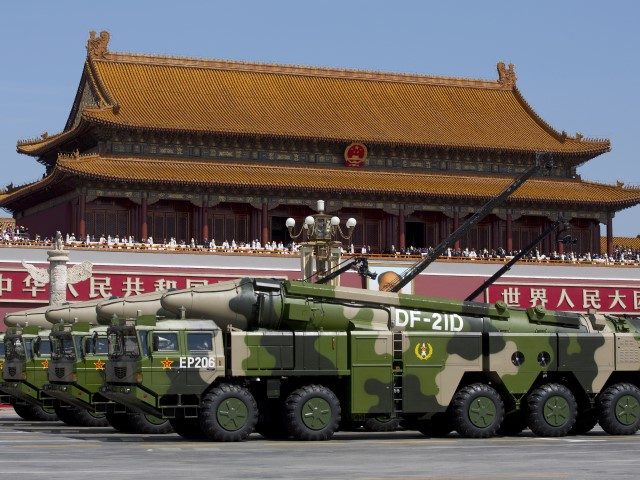Recent satellite images appear to suggest that China’s military has been practicing missile strikes on mock-ups of ships and targets resembling those operated by the Taiwanese and United States militaries in Taiwan and in the U.S. territory of Guam, respectively, the South China Morning Post (SCMP) reported on Thursday.
“The Chinese military has refined its anti-ship missile training from striking large, carrier-sized targets to smaller ships and naval bases, according to recent satellite images,” the Hong Kong-based newspaper reported on May 12.
“They show a training base in [China’s western region of] Xinjiang’s remote Taklamakan desert with the layout of mock-up ship moored in a naval base that resembles one in northeast Taiwan and other targets in Guam,” the SCMP detailed, citing the analysis of a Taipei-based naval expert.
The website of the non-profit United States Naval Institute (USNI) reported on the satellite images on May 11, saying it had reviewed the photos and determined that China’s military was likely “honing its ship-killing skills for potential future conflicts on new targets in a remote desert.”
USNI said that, based on the latest satellite images of Taklamakan Desert, “target sites have emerged forming a string of large-scale target ranges running along the eastern edge of the desert. … Several of these are naval and two have layouts that appear to be modeled on ships in port.”
“The nature, location and strikes on these sites all suggest the targets are meant for testing ballistic missiles,” according to USNI.
China’s military has recently ramped up military drills and actions designed to intimidate nearby Taiwan. The independent island nation is claimed by Beijing, in part due to its strategically important location along the nexus of the East China and South China Seas. China’s ruling Communist Party has vowed to “reunify” Taiwan, which is located just off China’s southeastern coast, with the “mainland,” or China, in repeated verbal threats over the past few years. This belligerent rhetoric has laid the ground for an increase in tactics employed by China’s military to harass Taiwan over the past several months. China’s People’s Liberation Army Air Force (PLAAF) orders near-daily air sorties to penetrate Taiwan’s air defense identification zone (ADIZ) as part of this intimidation campaign, and most recently deployed Chinese military aircraft into the sensitive zone on May 11.
Though the United States government does not maintain official diplomatic ties with Taiwan, Washington supports an unofficial relationship with Taipei’s democratically elected government. The U.S. Navy often orders its ships to sail through the Taiwan Strait, which separates Taiwan from China, in a show of solidarity with the small but politically and economically significant island nation.

In this Aug. 27, 2021, file photo provided by U.S. Coast Guard, Legend-class U.S. Coast Guard National Security Cutter Munro (WMSL 755) transits the Taiwan Strait during a routine transit with Arleigh Burke class guided-missile destroyer USS Kidd (DDG 100). The United States and China are stepping up their war of words over Taiwan in a long-simmering dispute that has significant implications for the power dynamic in the Indo-Pacific and beyond. (U.S. Coast Guard via AP, File)

COMMENTS
Please let us know if you're having issues with commenting.